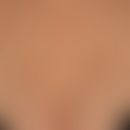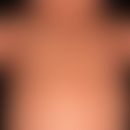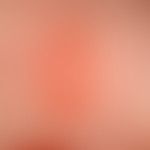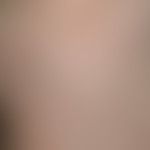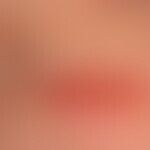Synonym(s)
HistoryThis section has been translated automatically.
Fox, 1877
DefinitionThis section has been translated automatically.
After maculopapular cutaneous mastocytosis (urticaria pigmentosa of the former nomenclature), the second most common manifestation form of cutaneous mastocytosis with localized, nodular, cutaneous mast cell proliferation presenting clinically as yellowish-brown, 1-10cm, sharply demarcated plaques or nodules.
You might also be interested in
ManifestationThis section has been translated automatically.
Occurs from birth or in the first months of life (90% of mastocytomas occur within the first two years of life).
Of all childhood mastocytoses, 20% occur as mastocytomas.
m:f=1:4
LocalizationThis section has been translated automatically.
ClinicThis section has been translated automatically.
Solitary or a few, rarely multiple, 0.5-5.0 cm in size, rarely larger (up to 10 cm in size), firm, brownish purple or brownish yellow, dome-shaped raised, painless nodules or plaques with a smooth (never scaly) surface.
The surface of mastocytomas is not smoothly atrophic, but shows either the normal relief of the field skin as in the surrounding area, or a slightly coarsened (lichenified) pattern. This morphologic sign is of diagnostic importance for differentiation from other proliferative processes (e.g., lymphoma of the skin). After rubbing the foci or after ingestion of codeine-containing drugs (Siebenhaar F et al. 2012), vigorous urticarial (more rarely even bullous) reactions ( Dariersche's sign), possibly combined with itching, may be induced. Warming also causes reactive redness (this is usually observed by parents when children are bathed in warm water).
A rare subtype of infantile mastocytosis is diffuse cutaneous mastocytosis, which becomes evident in the first weeks of life. It is characterized by a generalized, sulcid thickening of the skin. Mechanical irritation can cause urticarial dermographism.
HistologyThis section has been translated automatically.
The surface epithelium is inconspicuous. Usually the entire dermis is interspersed by a diffuse or nodular infiltrate of mast cells, which may extend into the subcutis. The cell type found in mastocytomas is monomorphic, oval or polygonal with a weakly eosinophilic cytoplasm and oval uniform nuclei. Eosinophils may be admixed in varying densities with the mast cell aggregates. The aggregates can be detected by monoclonal antibody against the SCF receptor (stem cell factor - CD117).
Differential diagnosisThis section has been translated automatically.
- Clinical Differential Diagnoses:
- Xanthogranulomas: mostly isolated, rarely multiple, color rich yellow, surface either coarsely furrowed or smooth; no Dariers sign!
- Granuloma glutaeale infantum: in typical localization on the buttocks in the diaper area; color brown; rough surface; no Dariers sign.
- Lymphadenosis cutis benigna (nodular form): predominantly occurring on the capillitium as asymptomatic, firm, red, brown to brown-red papules or nodules. Usually occurring beyond 1 year of age. Not a Dariers sign.
- Benige cephalic histiocytosis: brownish, flat, firm papules on the face and trunk. Dariers sign negative.
- Spitz nevus: solitary, reddish or reddish-brown, firm papules, Dariersche's sign negative.
- Histologic Differentials:
- Histologic DD include juvenile xanthogranulomas, Langerhans cell histiocytoses, melanocytic nevi, and B-cell type lymphomas. Unobtrusive epidermis, diffuse monomorphic cell infiltration of the dermis, typical cells with their pale eosinophilic cytoplasm, frequent histoeosinophilia, typical histochemical (Giemsa: metachromasia) and immunohistochemical behavior define mastocytoma beyond doubt.
TherapyThis section has been translated automatically.
Usually no therapy required; almost always spontaneous healing without complications. In case of itching, application of a local antihistamine such as Clemastin (e.g. Tavegil Gel). In the absence of regression or pronounced symptoms, excision may be considered (a rare option!).
External therapyThis section has been translated automatically.
Good effects were achieved by local tacrolimus applications.
Progression/forecastThis section has been translated automatically.
Regular regression within months to years until adolescence. S.a. Mastocytosis.
Note(s)This section has been translated automatically.
In cutaneous juvenile mastocytoses, the clear distinction between mastocytomas and maculopapular cutaneous mastocytosis is blurred. Thus, by definition, the diagnosis of mastocytoma(s) is made up to the number of 5 lesions. If there are > 5 "mastocytomas", the diagnosis is"maculopapular cutaneous mastocytosis". The "cutaneous mastocytoma of the adult" does not seem to exist in the type known in children! Known is the extracutaneous mastocytoma as a solitary benign mast cell tumor.
LiteratureThis section has been translated automatically.
- Fox WT (1875) On xanthelasmoidea (an undescribed eruption). Trans Clin Soc London 8: 53
Frieri M et al (2013) Pediatric Mastocytosis: A Review of the Literature. Pediatric Allergy Immunol Pulmonol 26:175-180
- Kang NG et al (2002) Solitary mastocytoma improved by intralesional injections of steroid. J Dermatol 29: 536-538
- Méni C et al (2015) Paediatric mastocytosis: a systematic review of 1747 cases. Br J Dermatol 172:642-651
- Shuangshoti S et al (2003) Solitary mastocytoma of the vulva: report of a case. Int J Gynecol Pathol 22: 401-403
- Siebenhaar F et al (2012) Chilldhood onset mastocytosis. Dermatologist 63: 104-109
- Sukesh MS et al (2014) Solitary mastocytoma treated successfully with topical tacrolimus. F1000Res 3:181
Incoming links (10)
Advanced systemic mastocytosis; Borrelia lymphocytoma; Cutaneous mastocytosis; Dermatofibroma; Granuloma gluteale infantum; Histiocytosis benign cephalic; Hyperpigmentation familial progressive; Indolent systemic mastocytosis ; Juvenile xanthogranuloma; Systemic mastocytosis ;Outgoing links (15)
Antihistamines, systemic; Borrelia lymphocytoma; CD classification; Clemastine; Darian sign; Diffuse cutaneous mastocytosis; Excision; Granuloma gluteale infantum; Histiocytosis benign cephalic; Juvenile xanthogranuloma; ... Show allDisclaimer
Please ask your physician for a reliable diagnosis. This website is only meant as a reference.
